
southeast asia
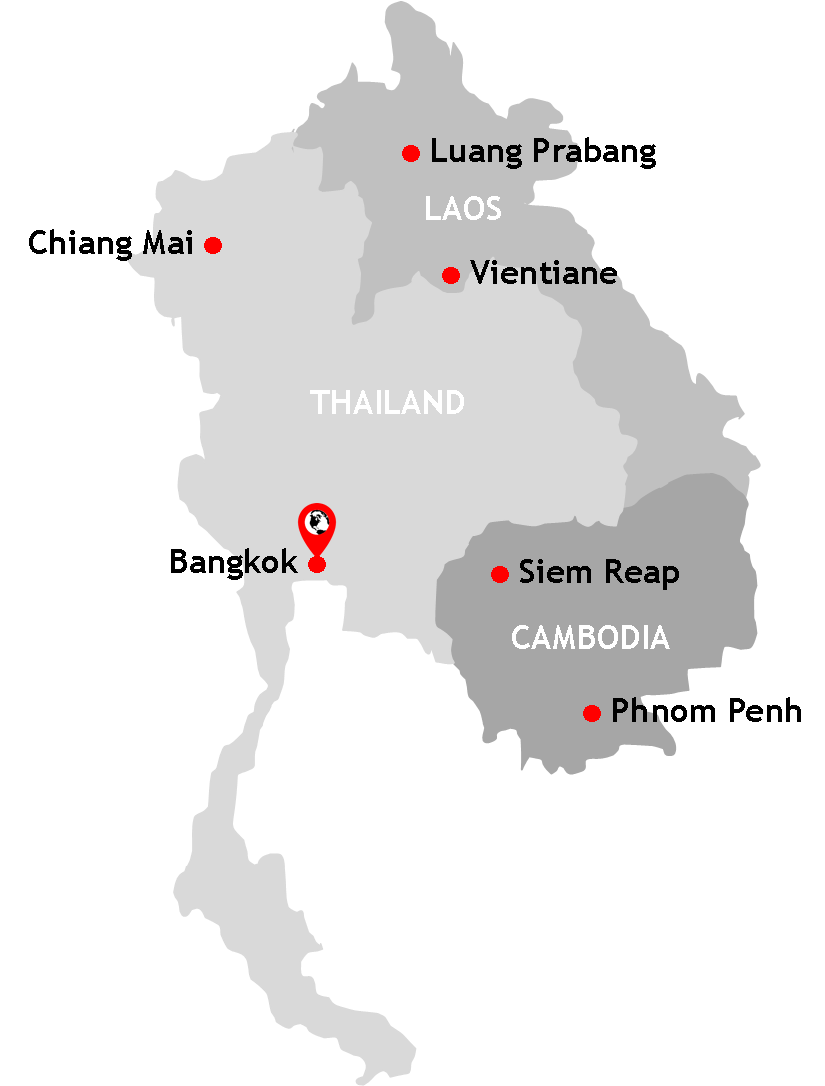
Where: Bangkok & Chiang Ma, Thailand. Siem Reap & Phnom Penh, Cambodia. Vientiane & Luang Prabang, Laos.
When: December 2019 and January 2020
What: Grand Palace Bangkok, Wat Arun, Wat Pho Reclining Buddha, Rooftop bar, Monks marking exams, Ratchada Rot Fai night market, Angkor Thom, Angkor Wat, Bayon Temple faces, Tonle Sap Lake, Samatoa Lotus Farm, The Killing Fields, S-21 Prison, Phat That Luang, Putaxai Arch, Haw Pha Bang temple, Bamboo bridge, Kuang Si waterfall, Mekong River at sunset, Tak Bat Alms ceremony, Wat Phra Singh, Doi Inthanon national park, Water buffalos, Wat Phra That, Wat Phantao, Doi Suthep, Silver Temple.
How: International flights, domestic flights, tuk tuks, taxis, walking, motorboat.
Country counter: No. 89, No.90 & No.91
Illnesses or mishaps: several nightmare hotel stays which had us constantly switching hotels; contracting a virus at the start of the journey which took two courses of antibiotics to get rid of; developing temple fatigue.
It seems like I've been saying that I'm going to explore Thailand, Cambodia and Laos for years, this three country adventure through Southeast Asia originally intended for 2018. In 2019 we finally committed to seeing three of the most captivating countries in Asia.In the consciousness of many, Southeast Asia is the quintessential backpacker destination, a place synonymous with young people from Western countries hoping to discover themselves by discovering Southeast Asia. I was about two decades late to this Asian party. The reality is that Southeast Asia is popular and this brings with it problems - particularly if you're looking to go somewhere a little off the beaten path. Many lazily refer to backpacking around 'Southeast Asia' as if it is a single homogeneous block which, of course, it isn't. Although often tiring, a journey through several countries in the same region of a continent allows a traveller to see the obvious similarities but also tease out some of the important differences. I found the slight variations in tuk tuk designs and head wear, for instance, rather satisfying to observe as I transitioned from country to country. Whilst seeming superficial they're rather revealing about the culture which created them.
In the end my Southeast Asia journey calculated thus: three weeks, six destinations across three countries, eight passport stamps, eight separate flights (both international and domestic) and approximately 27 hours high up in the air.
thailand
The Heart of Southeast Asia
I have to admit that I was a little indifferent about visiting Thailand. I put this down to two things: I have already worked my way through the two neighbouring Asian greats of Burma (Myanmar) and India as well and the fact that Thailand is a bit of a clichéd destination. It seems that everyone has been to Thailand at some point in their life and so heading here didn't feel very adventurous nor intrepid. Add to this the reality that Thailand also has a bit of a sleazy reputation, frequented by sexpats and pop-marked with dubious massage parlours offering additional services. Indeed, the only reason I was heading to Thailand was because it was the obvious gateway into this region of Asia. Thus I entered into my 89th country with some trepidation and a degree of travel cynicism which, ultimately, wasn't tempered during my time there.
bangkok
Bangkok is a heady concoction of traffic, pollution, and colour - all heated to a steamy 35 degrees. It is a crazy place that would challenge any inexperienced traveller but, to be honest, it's nothing I haven't seen before in other big cities on the continent: noise, stench, dangling power cables, broken pavements and hawkers galore. Bangkok is one of the biggest cities in the world. Indeed, taking in the view from one of the city's many rooftop bars is the quickest way to get a sense of its gargantuan size. It's awesome - in the original sense of the word. We based ourselves in the Sukumvit district of the city, a place where low and high-end hotels rubbed shoulders with massage parlours (to be honest, if you manage to stay in a part of Bangkok where there aren't massage parlours then you're clearly not trying). The frequent, tired wails of "massar sir" from girls lining the streets was all very harmless - although probably not entirely innocent.
By way of a much needed contrast, Bangkok's temples and palaces offer a slice of traditional Thai culture on a far more human scale - a welcome change from the vast and vertical glass cityscape. It is quite possible to see the Grand Palace, Wat Arun and Wat Pho in half a day depending on how much time you care to spend wandering around each one. Unsurprisingly, being at the top of the Bangkok must-see list, expect to find each one crammed with visitors wielding selfie-sticks and crying children - no matter what time of day you visit. In the intense heat of a Bangkok December, the crowds and noise can quickly become overwhelming to even the most zen and tranquil of souls. We visited at around nine in the morning and already hordes of tourists were snaking around the block. It's virtually impossible to marvel at the exquisite details of what are Thailand's architectural gems with approximately half of Asia there with you afflicting virtually every one of your senses. The temples of Wat Arun and Wat Pho proved to be less of an assault than the Grand Palace and, while less impressive than the King's former residence, were far more enjoyable as a result. A trip out to the Wat Suthat temple offered an even more laid back experience and coincided with a Buddhist ceremony characterised by fluttering white flags, visceral music and a two score of people waiting expectantly in their seats. Wat Suthat was also populated by monks at plastic tables who were seated around the perimeter of the main temple engaged in what appeared to be a kind of synchronised marking of important papers. This was an opportunity to experience something of Thailand which was not tourist theatre nor corrupted by the presence of foreigners in large numbers. Instead, it was authentic and for this reason I appreciated it. As tourism booms around the world these authentic, more quieter moments are becoming increasingly hard to find.
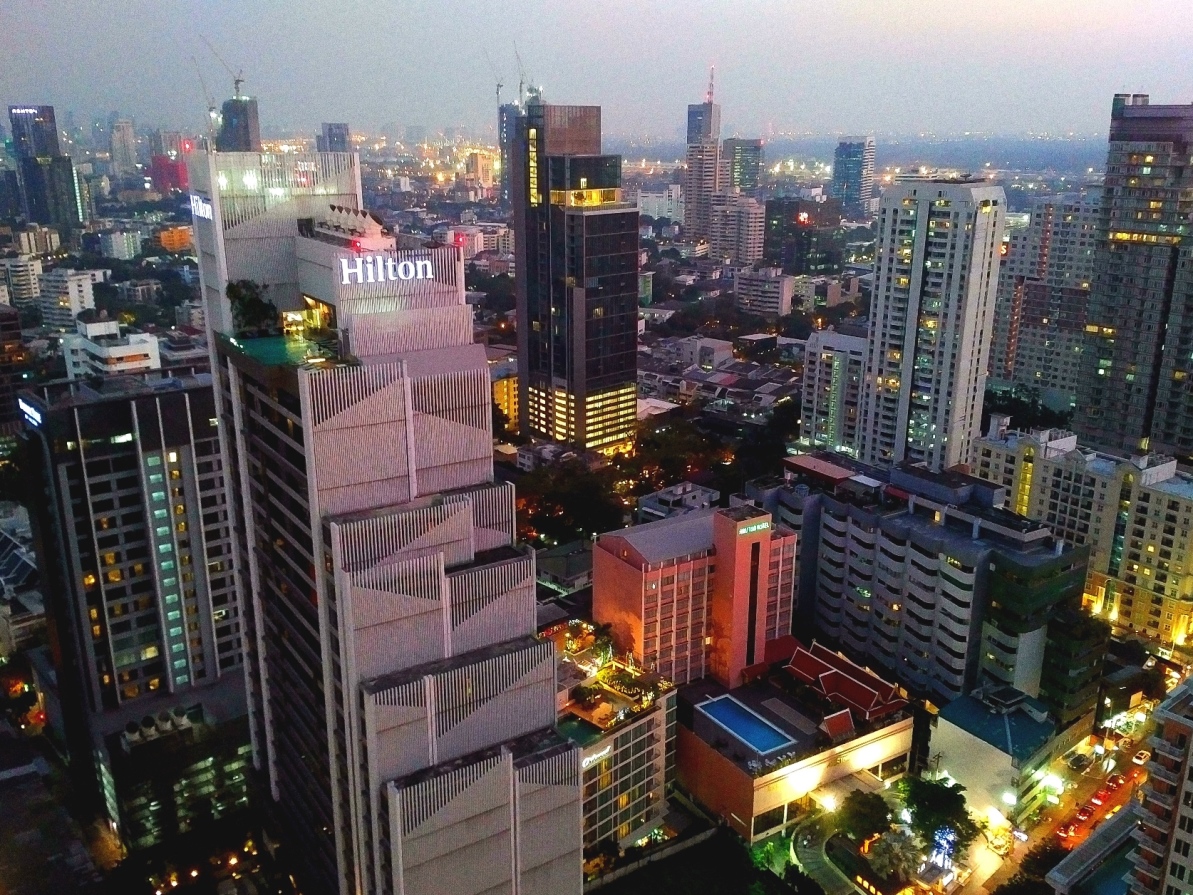
The inhumanity of Bangkok seen from a rooftop bar.

Wat Pho temple's technicolor stupas.

Wat Pho Buddha worship.
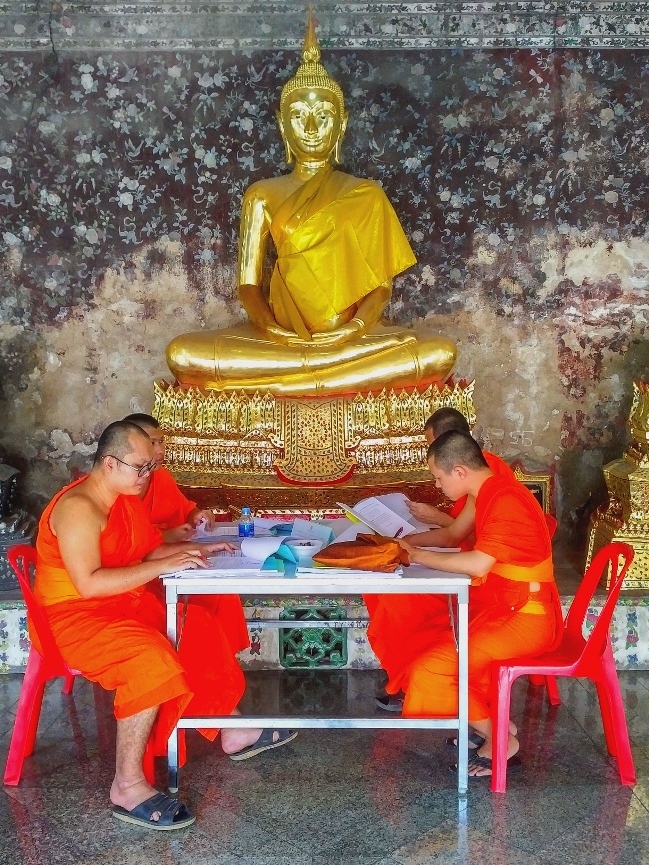
Buddhist monks marking papers at Wat Suthat temple.

The Reclining Buddha at Wat Pho.

The colourful canopies of the Ratchada Rot Fai night market viewed from above.
chiang mai
Chiang Mai was actually the last of six destinations across the three countries having flown into Bangkok and travelled from Thailand to Cambodia and then Laos in an anti-clockwise direction. We landed in Chiang Mai having travelled from Luang Prabang in Laos. I thus arrived in this northern Thai city tired and a little jaded; this was the last stop and my energy - and my interest in temples - had waned. We had two full days to experience something of northern Thailand before catching our final flight home to Sydney via Bangkok.
Pressed for time, we based ourselves in a little hotel in Chiang Mai's old town area - we were so close, in fact, that the top of the golden Wat Phra Singh stupa could be seen from our hotel room window peering over the humble tin rooftops of dwellings opposite, positively glowing in gold like a beacon at night. I could almost touch it. I experienced the city as a veritable tangle of streets comprised of problematic sidewalks (problematic because mostly they didn't exist), crazy cables dangling overhead and unedifying smells emanating from drains or piles of refuse. In many ways Chiang Mai is little different from many of the destinations I visited on this journey. By this point, everything began to feel "same same" (as they jokingly say in these parts). If you're a fan of temples and all things Buddhist then Chiang Mai is certainly worthy of some itinerary time. Admittedly it is home to some of the more unusual renditions of the Buddhist temple, seen most obviously in the Silver Temple - an otherworldly feat of design which hovers somewhere between gingerbread house from the Hansel and Gretel fairy-tale and the kind of hut you might expect to see frozen in snow on the front of a Christmas card.A day trip out up to Chiang Mai's Doi Inthanon national park, described by some as the "Roof of Thailand" being, as it is, the highest mountain in the country, was intended as a chance to escape from temples but, alas, we ended up visiting three more on our way back down the mountain. Temples: there really was no escape.

The golden stupas of Wat Phra Singh.
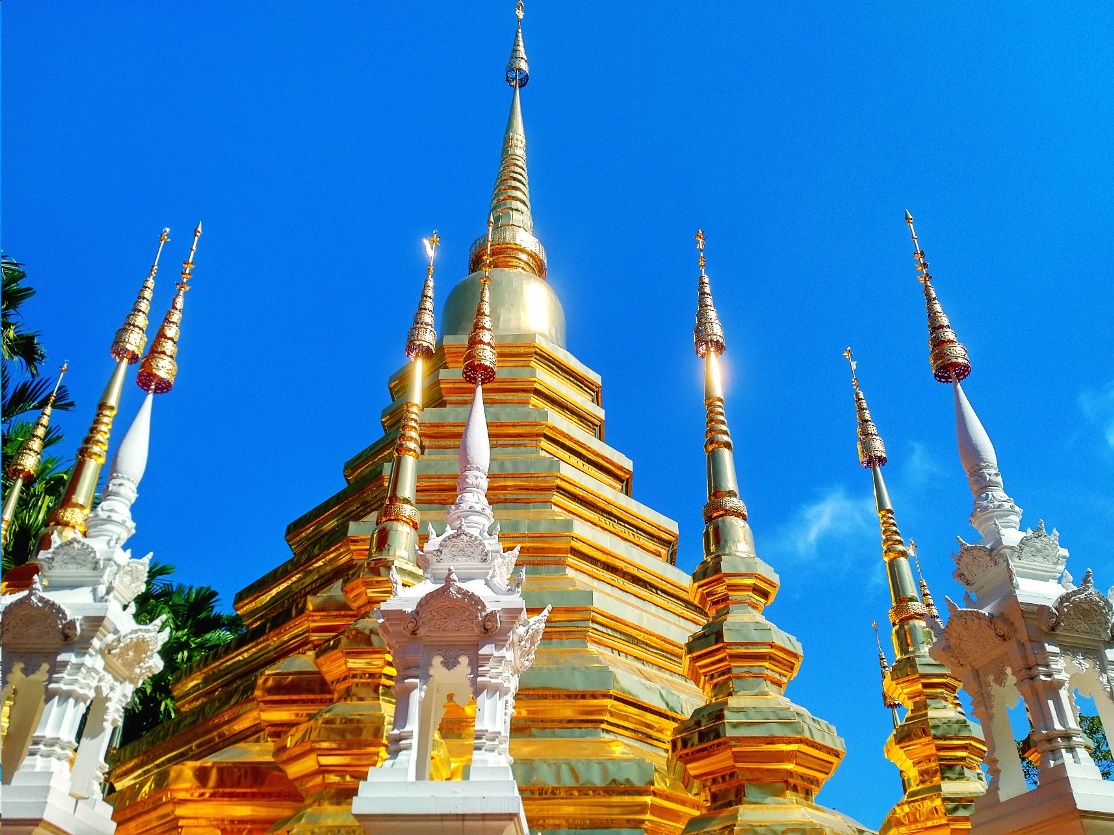
Wat Phantao stupas in gold and white.

Ghostly Buddhas and a spiritual kaleidoscope of colour at Wat Inthakhin.
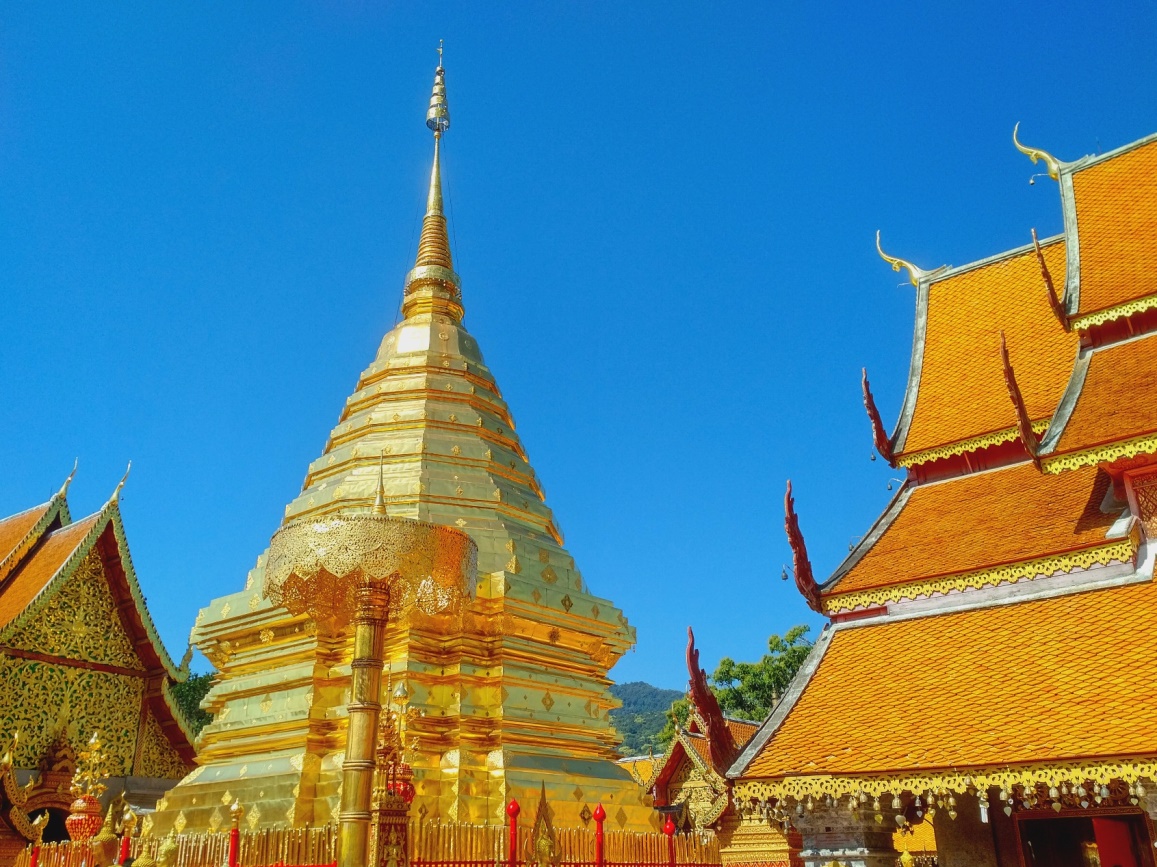
The Wat Phra That on Doi Suthep mountain.

The otherwordly emerald Buddha at Wat Phra That.
cambodia
Land of the Khmers
Sometimes you touch down in a country and immediately get the feeling that you're going to like it there. I got this feeling about Cambodia. It's difficult to explain how this feeling works or where it comes from; it probably has just as much to do with whether you had a good sleep the night before as it does with any special traveller intuition. In the modern psyche Cambodia is both famous and infamous. Temples like Angkor Wat, Ta Promh and Angkor Thom draw visitors, like a magnet, from all over the world. Conversely, Cambodia's name is also indelibly stained by the extreme communist Khmer Rouge, one of the world's most brutal regimes which, under the leadership of Pol Pot, murdered a quarter of all Cambodians in just four years. Cambodia is both a beautiful and a sobering place to travel. I found myself wrestling with this unsettling dichotomy throughout my time in the country; there's an effervescence but also a sadness in the air.
Cambodia has a vibe all of its own which was a welcome counterpoint to the frenetic Bangkok. Cambodia was a mere 35 minute flight from the Thai capital and, touching down in Siem Reap I, quite significantly, entered my 90th country. On reflection I can't help but feel it was fitting that this country in particular, being such a warm place, was to be such an important travel milestone for me.
siem reap
Our Siem Reap adventure began immediately with no time to calibrate nor adjust our sensibilities in a leisurely air-conditioned airport transfer car. Instead, rather, we were bundled into the back of a tuk tuk and whizzed through the streets at break-neck speed, dodging through the morning traffic, taking in the smells, sights and sounds of a place up close and, all the while, our rucksacks bounced crazily on the seat in front of us. It was without doubt the most thrilling and authentic airport transfer I can recall. Siem Reap is characterised by dusty streets packed with tuk tuks, micro businesses and mobile shops on wheels. Cables of every girth criss-cross above the sidewalks.
Siem Reap has long been a fixture of the backpacker scene. The Temples of Angkor are almost solely responsible for this footfall and as night follows day Siem Reap has developed and expanded to cater for the needs of travellers. Inevitably this has thrown up some garish aspects, namely Pub Street which, as its grimly functional name alludes, is a large street with all manner of alcohol-related shenanigans lining either side. And that's okay - especially considering that it is quite possible to avoid the whole area and have a more sophisticated time of it if that's your thing. Being firmly on the beaten track, Siem Reap has developed somewhat of an alternative, hippie vibe meaning that the food scene is positively buzzing with vegan and vegetarian options. The food we ate in Siem Reap was some of the best we'd tasted during the entire trip.
Of course, we were in Siem Reap to explore the temples and, as if by way of a gentle warm-up, we eyed the Wat Preah Prom Rath temple across the street from our hotel and took to wandering around marvelling at the strange technicolour statues which populated its grounds - like fantasy characters from the mind of the most wacky of literary geniuses. The architecture of the temple, characterised by rectangular patterns achieved by different coloured roof tiles, decorative gold flourishes and pointed roofline edges gesturing toward the sky, seemed to speak so much of the country I now found myself in (I love the way architecture has the power to do this). With a quick foray to purchase a three day Temples ticket and a largely unsuccessful attempt to see Angkor Wat at sunset, that was day one in Cambodia complete. We would spend the next two days in the searing heat travelling by tuk tuk around our chosen temples: Angkor Wat, Bayon, the south gate of Angkor Thom and Ta Promh. The popularity of these places inevitably dictates there will be others there no matter what time you visit. Indeed, even a traveller with the most vivid imagination would struggle to whisk their mind away from the noise, pushing, shoving and frayed tempers of visitors desperate to get that magical photograph. The reality is that we shared our once-in-a-lifetime Angkor Wat moment with approximately 90% of Asia. In the hot temperatures (around 34 degrees) and humidity, the experience hovered somewhere between paparazzi tabloid nightmare and a hot Hindu Disneyland. Some of the lesser-known temples were far less of an ordeal, with the numbers of visitors falling away quickly compared to their more famous counterparts. For this reason alone it is worth getting your tuk tuk driver to take you to a few of them if only for some respite from the crowds.
Angkor Wat at sunrise the following day afforded us the chance to photograph the iconic towers from a distance and among a more muted, mature crowd of travellers. We set off from our hotel at 5am in order to make the journey by tuk tuk to the shores of the lake, speeding through the dark and quiet dusty streets. By half past the hour we were lakeside and the pinks and purples of daybreak were beginning to light up the sky. By full sunrise a couple of hundred people had quietly accumulated along the banks: there were the serious photographers completely focused on capturing the best photograph their equipment could muster, those just there for a quick snap and some, like the lady sat next to me, were after somewhat of a more spiritual experience positioned, as she was, with her legs crossed and looking serenely out across the water toward what is probably the world's most famous temple. As the pastels faded to be washed away by yellows then bright whites, the crowd dissolved into another Siem Reap day. We made our way over to the temple with the hope of sampling its greatness in relative peace compared to the previous day - it was 6am after all, we reasoned. Idiots. That was naïve. However, having travelled to many of the world's most iconic sights (the Taj Mahal, Petra, Niagara Falls, Table Mountain, The Great Wall) I have learned to anticipate and prepare myself for the rather noticeable disconnect between expectation and reality. I've found that it's best to approach the world's most famous landmarks pragmatically and often with expectations adjusted firmly downwards; I know from having been to nearly half the countries in the world now that often it's the things you see along the way, or the sum of its parts, which make a journey memorable or worthwhile rather than any single landmark. Our Southeast Asia adventure was not to be made of Angkor Wat alone and I comforted myself with this fact.
Vanny, who was quickly turning into our personal tuk tuk driver stationed, as he was, outside our hotel, suggested a trip to the Chong Khneas floating village in the Tonle Sap Lake. This was one time when I got a sense of a slightly darker side to Cambodia's tourist market; boat prices were exorbitant and there was a real hostility in the air towards tourists. Luckily, en route to the village we spotted the Samatoa Lotus Farm, a cute place on the banks of the lake with lines of traditional farmers' shacks made of wood and palm leaves. Paths wound their way round and past dark green pools with lotus leaves - some with pink flowers in mid-bloom. Samatoa saved what was an unappetising morning spent at Chong Khneas.
Our final day was mostly restful, with the odd foray across the street to the vegan and vegetarian restaurant which had become a second home. In the early evening, as a sort of final flourish and on the spur of the moment, we decided to head out to the Wat Bo Buddhist temple, the oldest in Siem Reap. Luckily Vanny was outside with his tuk tuk as usual and this meant we were quickly on our way - fortuitously as it turned out because it resulted in us catching the final few minutes of the Monks' evening prayers. It was just enough time to experience the ambience and soak up the chanting before the monks dispersed about their evening duties. It was a fitting end to our time in the city.
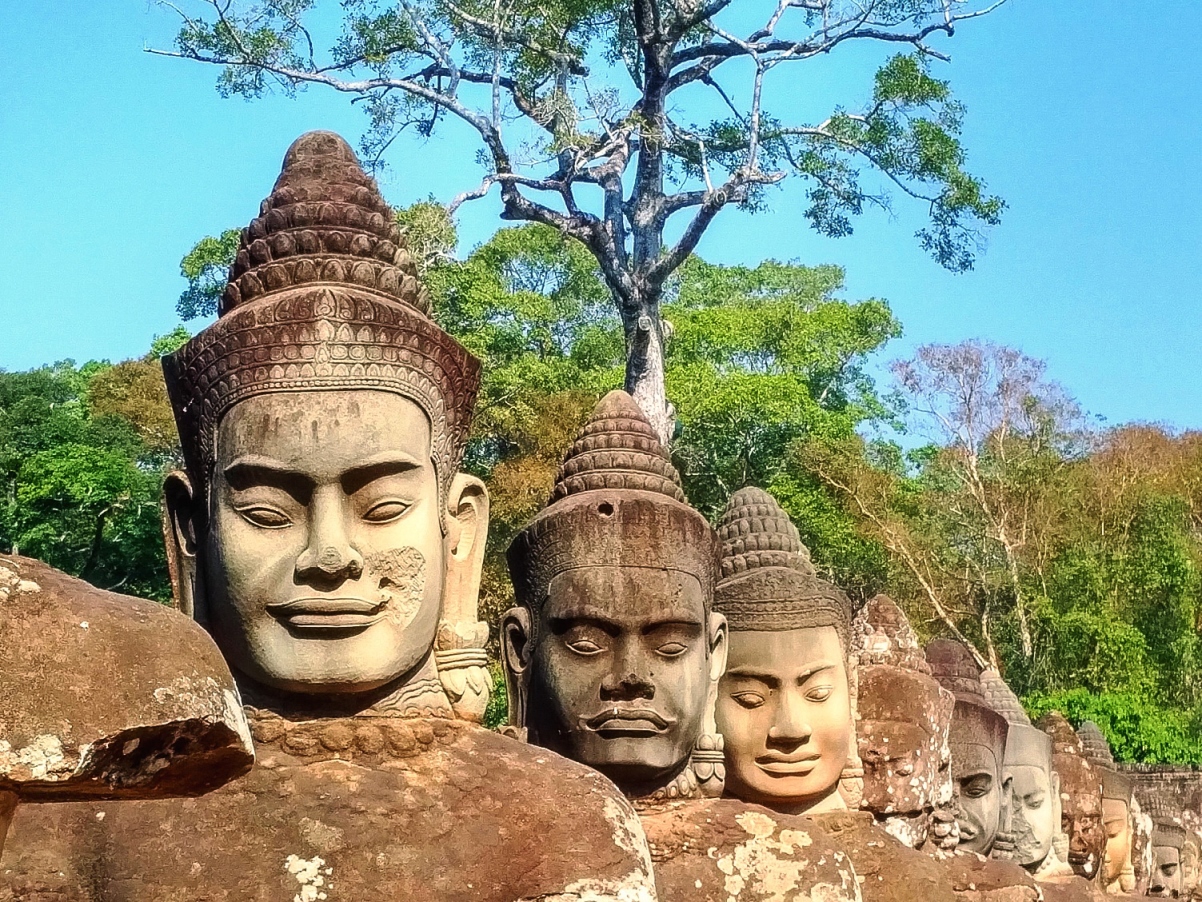
Statues on the southern approach to Bayon, part of the Angkor Thom temple complex.

Iconic travel: the dramatic Bayon faces at Angkor Thom temple.
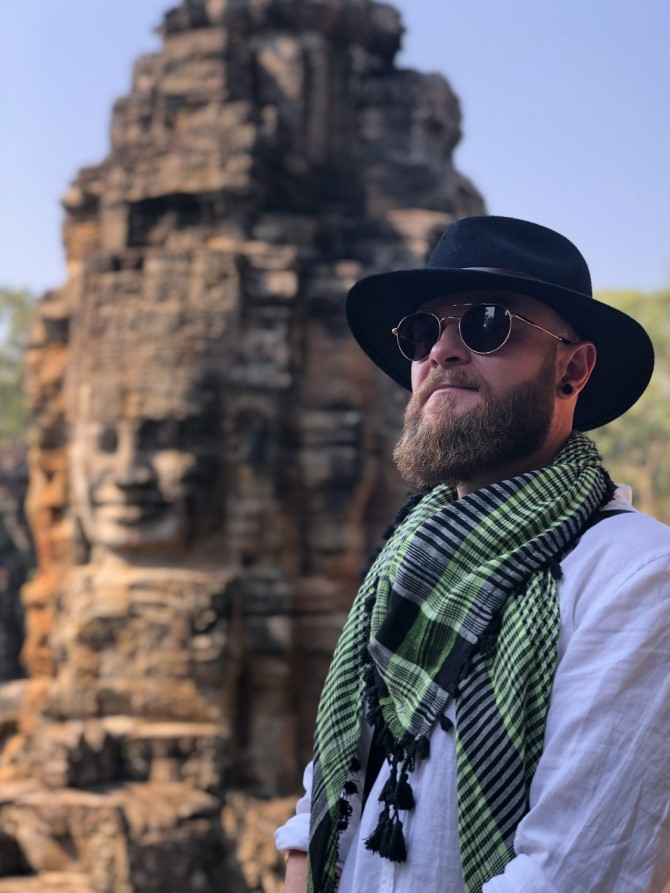
Angkor Thom temple, more famously known as the Smiling Temple.

Bayon of Angkor Thom through the trees.
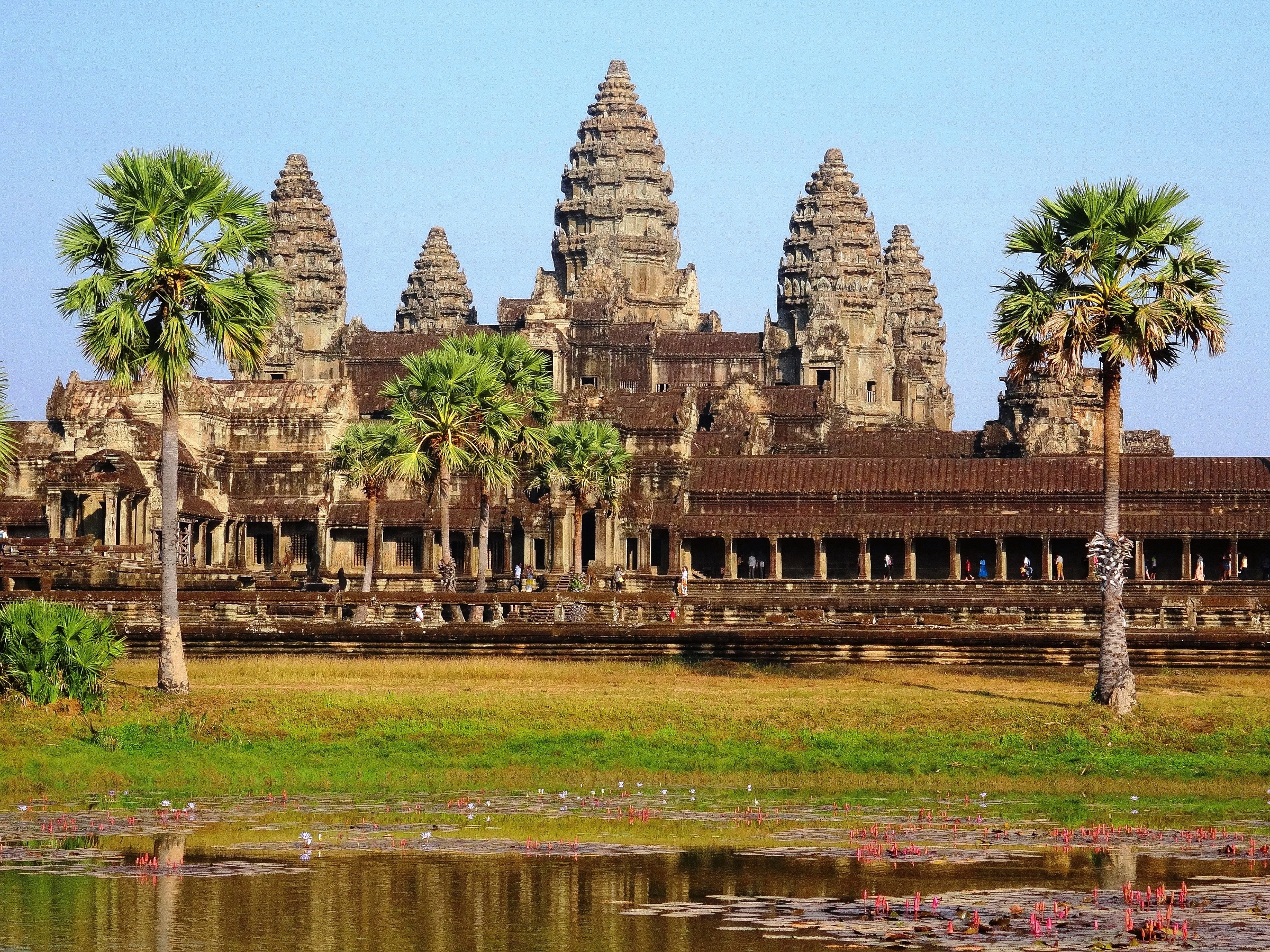
Angkor Wat Temple reflections.

Inside Angkor Wat Temple.

The lichen-covered Ta Promh, fittingly known as the Jungle Temple.
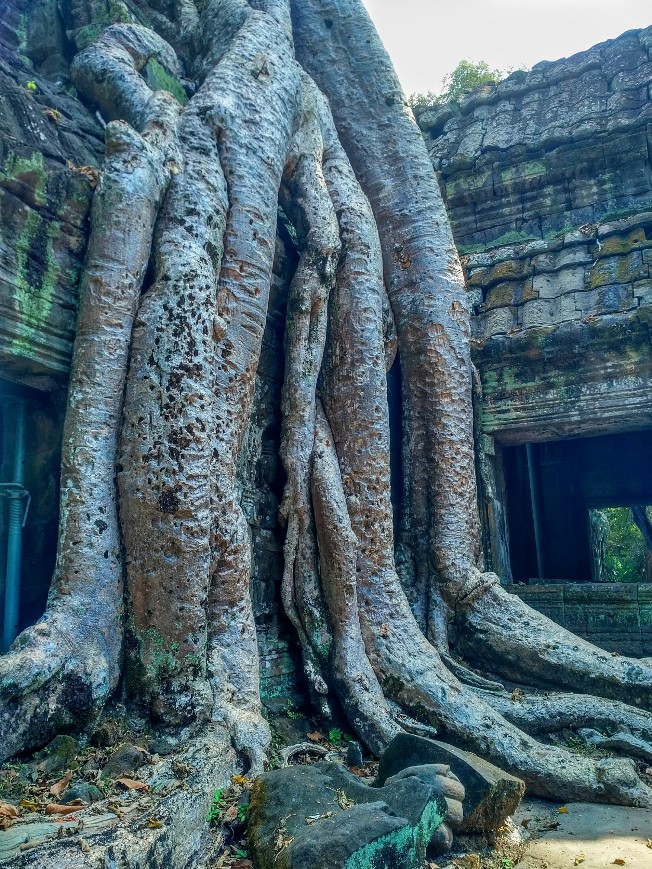
Silk Cotton tree roots at Ta Promh ooze over walls.

The wonderful Samatoa lotus farm which we passed by chance. We wandered around enjoying the authenticity of the traditional farmers' huts and blossoming lotus flowers. Sometimes the best things in travel happen along the way.
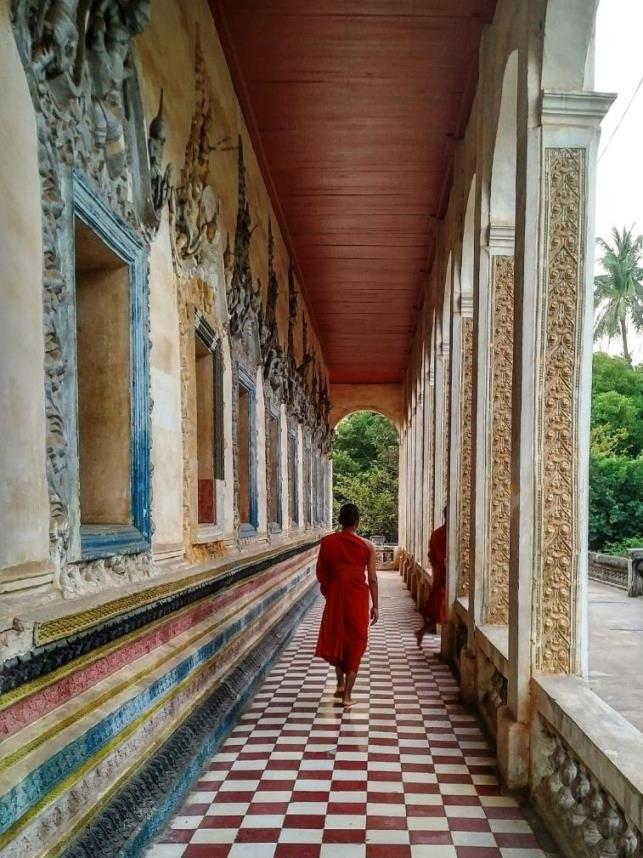
A Monk leaves Wat Bo temple, the oldest in Siem Reap, after prayers.
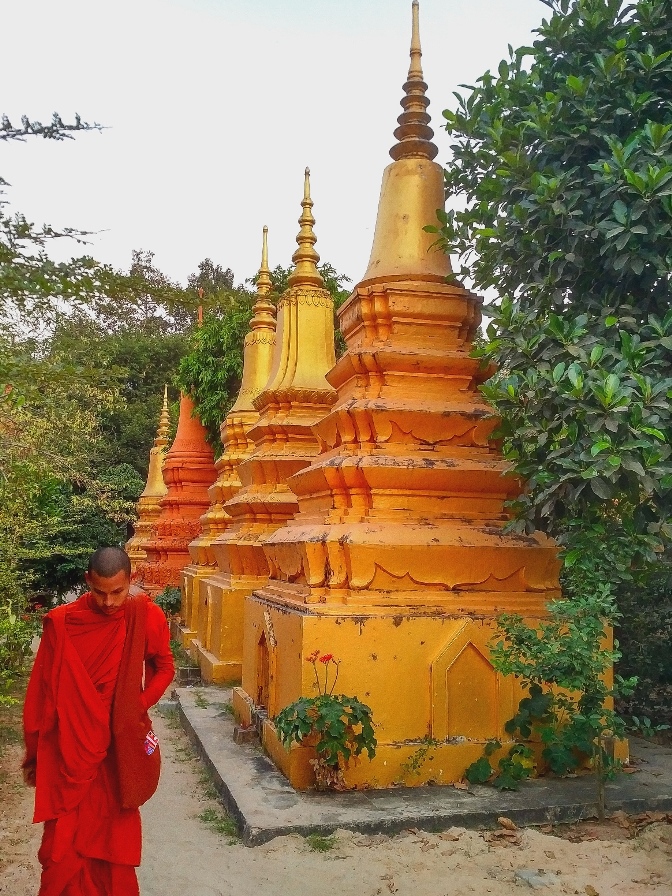
A Monk passes a line of large stupas as the light fades at Wat Bo .
phnom penh
Decadently we flew the short distance between Siem Reap and the Cambodian capital. In hindsight it may have been better to have hired a driver or caught a coach but our itinerary was put together at some speed and flights were easily bookable online. We flew with another little-known airline, Cambodia Angkor Air, a small plane which came complete with propellers. Usually I am extra nervous on these planes but, with a flight time of only 40 minutes, there was barely any time to get jittery before the plane began its descent and we were back on firm ground again.
Immediately I sensed Phnom Penh was different. Whereas Siem Reap was laid back and kind, the capital had an angrier, grumpier vibe. This found expression in more invasive tuk tuk drivers, an unpleasant hotel experience which had us checking out two days early and heading to the nearest four star hotel, the sight of men unashamedly urinating up against walls in broad daylight and the general underdeveloped and disgusting state of the city which had me quickly drawing parallels in my mind with my time in India. I began to thank my stars that we had apportioned only two full days here. Two days was enough.
On our first full day in Phnom Penh, and the first day of 2020, we hired a tuk tuk driver by the name of Thon, to take us to two places etched into the psyche of Cambodians and, indeed, probably anyone old enough to remember the reign of Pol Pot and the Khmer Rouge in the 1970s. We started at the former school which was transformed by the regime into a torture prison known as S-21 (now the Tuol Sleng Genocide Museum). The cells and chambers, once former classrooms, were grim indeed. In most stood a solitary metal bed frame underneath which the floor tiles were heavily discoloured. In case you were naïve enough to not know the reason why, a grainy black and white photograph hung on the wall depicting incidents therein. I'll spare you the details and leave it to your imagination as to what took place in these rooms to affect such indelible stains. As the heat of the day intensified we hopped back on Thon's tuk tuk and headed out to Choeung Ek - known to most as The Killing Fields, an area of the countryside where the regime eliminated its so-called enemies in the most sadistic ways imaginable. The audio guide, in my experience so often dull beyond belief in museums and other attractions, was truly confronting. The focal point of remembrance - and it is about remembering the millions who perished - is an elegant stupa with characteristically Cambodian architectural flourishes. However, its elegant exterior belies the horror inside: hundreds of human skulls are arranged in scientific categories and detail the cause of death. Indeed, bones continue to reveal themselves as the fields slowly give up their secrets, bone by bone, fragment by fragment, shred of cloth by shred of cloth. We were instructed to stay on the wooden path for fear that we may unknowingly, and disrespectfully, tread on the fragments of those who perished here.
Nowadays these fields, which have borne witness to the darkest recesses of humanity, has a deafening silence and serenity about it; beautiful birdsong and, incongruously enough, mother hens wandering around with their chicks instructing them, from what I could see, on how to dig. The tranquillity of Choeung Ek elicits reflection without explicitly asking for it. Quite clearly this is not everyone's idea of how to spend New Year's Day or, indeed, the start of a new decade but, as I've argued on my site many times before now, travel should seek to go beyond the beach and beyond the resort. Choeung Ek and S-21 are about as far from the beach holiday as it is possible to get.
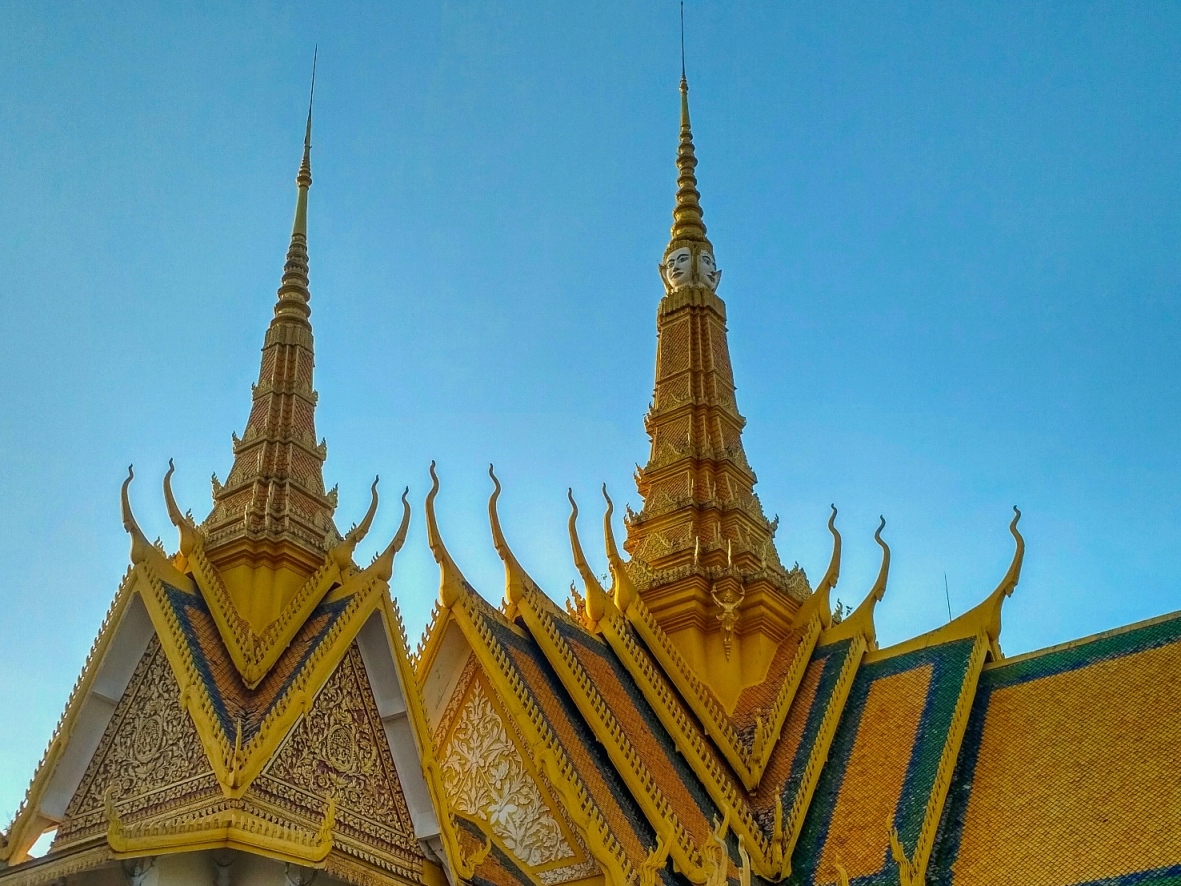
The golden roofline of the Royal Palace. I particularly love the facial detail on the central spire, reminiscent of the smiling faces of Bayon at Angkor.

The memorial stupa standing in the grounds of the Genocidal Centre, more commonly known as 'The Killing Fields'. This area is the location of many mass graves. The stupa contains hundreds of human skulls in giant display cabinets.

A sobering day spent on this the first day of a new year. This is one of the cells, once a former classroom, at the S-21 prison, used by the Khmer Rouge regime to torture and murder its own people. Other sights at this, the now Genocide Museum, were far more horrific. Out of respect I've chosen instead a photograph which isn't confronting but captures something of the atmosphere of a place such as this.
laos
Southeast Asia's Socialist State
The Laos People's Democratic Republic, or Laos PDR for short, was the country I knew the least about. I knew it was poor and communist but that was as far as my understanding of the country stretched. Embarrassing I know but perhaps this is telling in itself; Laos is quiet, unassuming and humble. This made it more appealing - as did the fact that it is the least-visited country of the trio. I've frequently had good experiences in places where there are fewer visitors and so relished the chance to see a country which was, comparatively at least to Thailand and Cambodia, a little off the well-trodden path. Laos is a little less impacted by the tourist Dollar and so, in its sleepy state, offers the chance to sample Southeast Asia more authentically - although things, many agree, are changing rapidly. This little socialist nation, and one of the least explored countries in Southeast Asia, became by 91st country.
vientiane
Vientiane is the little-known capital of Laos and is more often than not bypassed by the majority of visitors keen to press onto other parts of the country. We'd apportioned two full days across three nights - the general consensus online - to see what sights the city had to offer. Thankfully, Vientiane turned out to be Bangkok's opposite. It has all of the same ingredients of other Southeast Asian capitals but on a far more human scale. After experiencing Asian city life on steroids in Bangkok and the harshness of Phnom Penh, I was glad to make it to a place which instantly felt more measured and personable.
To dismiss Vientiane as some are inclined to do is a mistake; it has some of the most incredible Buddhist temples I have ever seen - some weathered by time, others newly painted in vivid technicolour. Designs are exquisite and intricate and, unlike with some religions, you are pretty much left to your own devices to wander around at your leisure and photograph what you wish (providing you remove your shoes and hat first, that is). The Phat That Luang, with its golden stupa, and lit in double gold by the yellowy afternoon sunshine, was incredible and probably worthy of the trip to Vientiane just in itself.
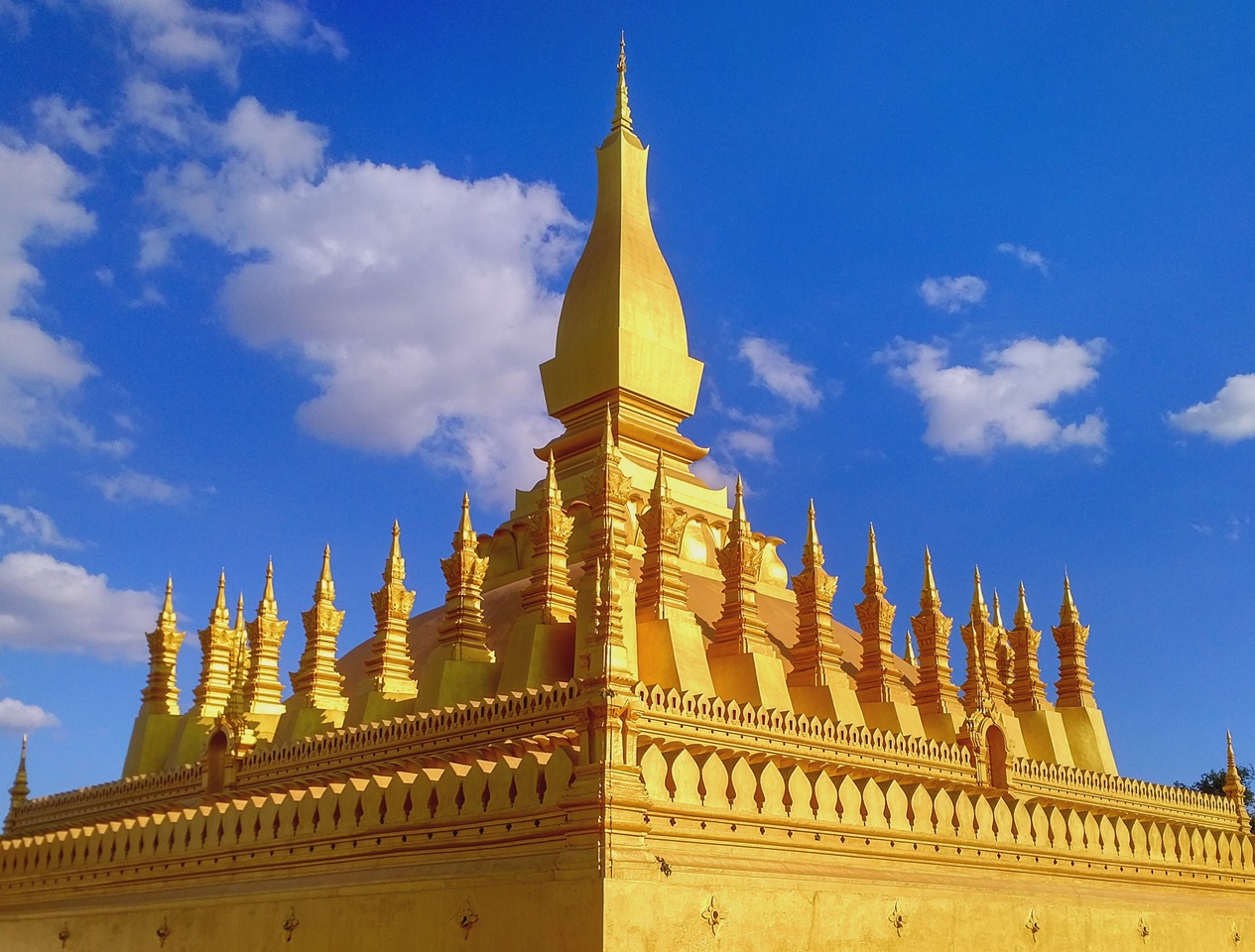
Phat That Luang, the national symbol and most important Buddhist monument in the country. We caught it in the mid afternoon, the softening yellow light from the sun adding an extra layer of gold to an already golden stupa.
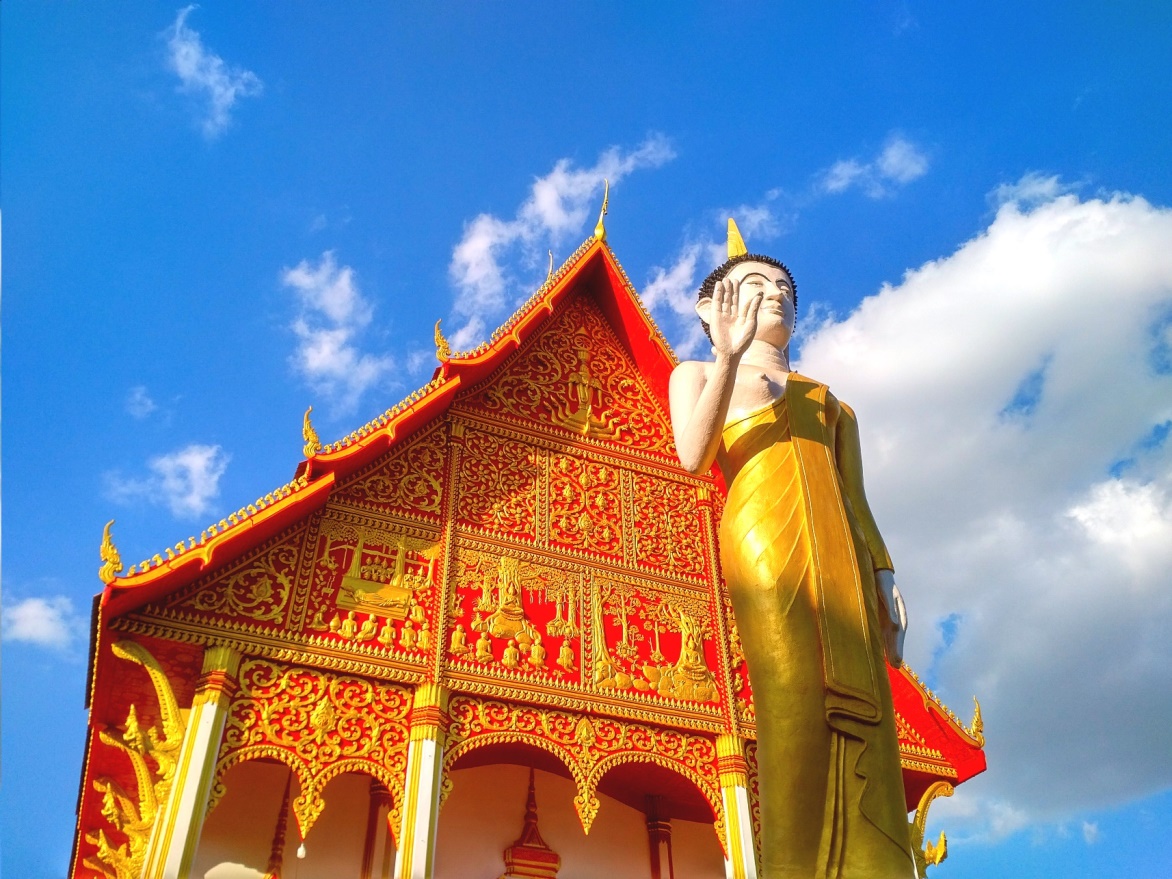
The awesome Wat That Luang Neua Buddhist temple.
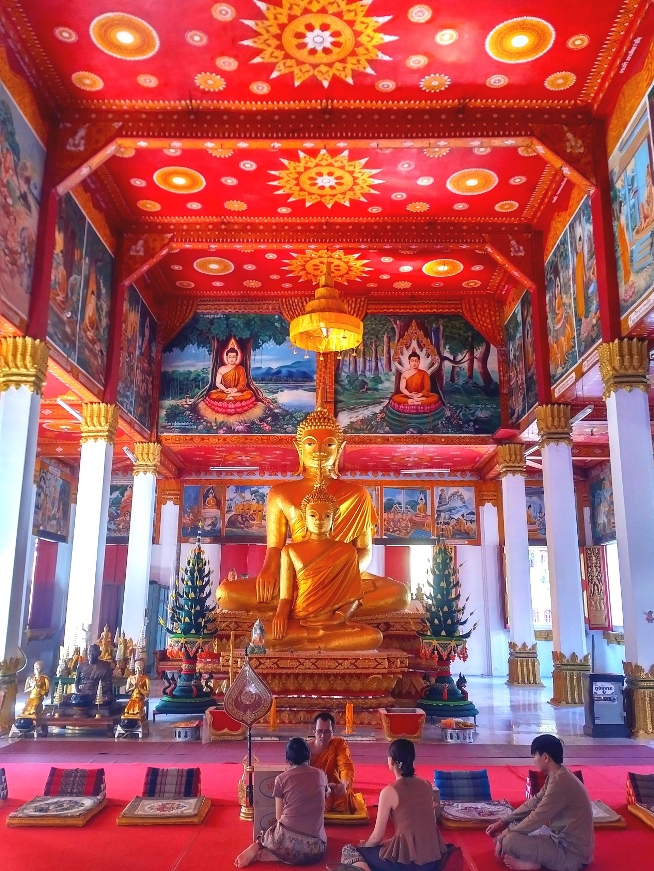
Conference with a monk at the Wat On Teu temple.

Window detail at the Wat On Teu temple.
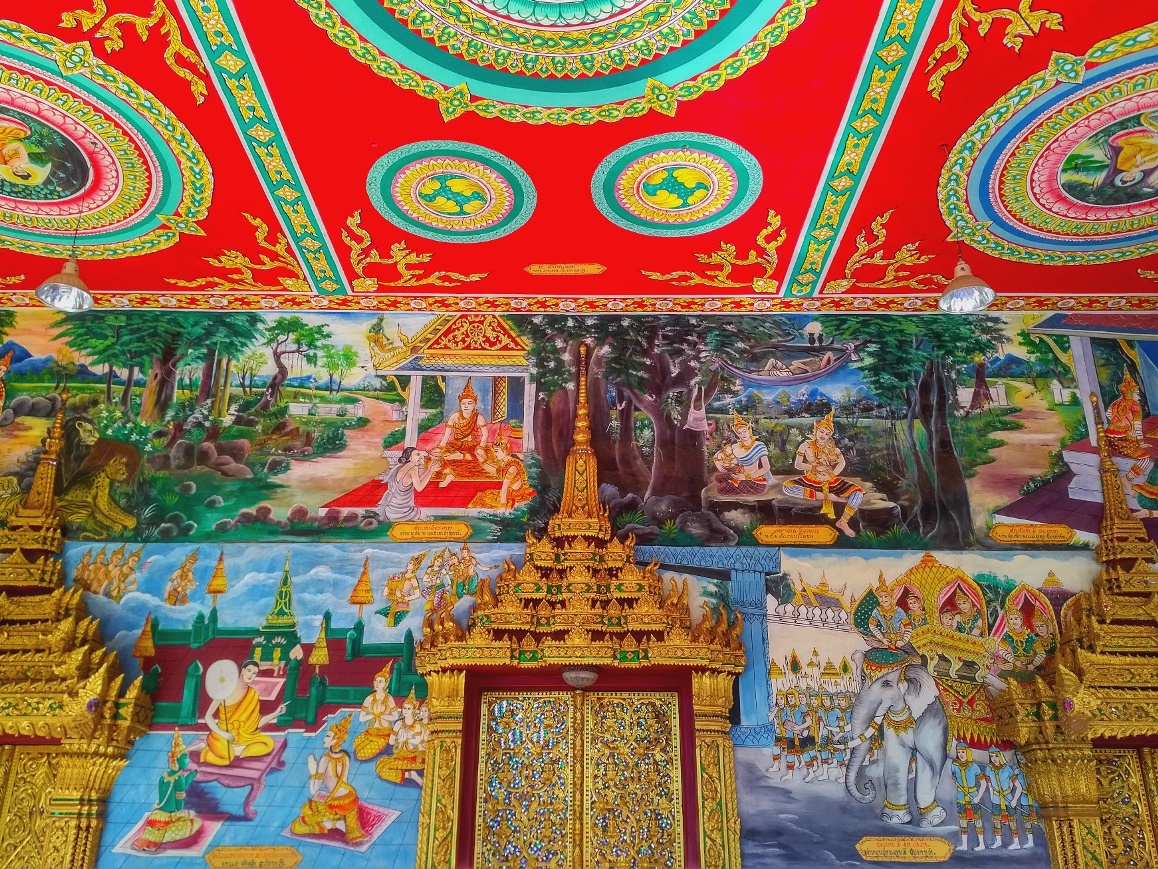
The incredible frescos on the exterior of the Wat Inpeng temple. This temple which features on the front cover of the Lonely Planet Guide to Laos.
luang prabang
After so many cities Luang Prabang heralded a much-needed shift. We were now in northern Laos - far away from Vientiane, Phnom Penh, Bangkok... The dramatic view of the mountains as we flew into Luang Prabang seemed to signal that we had, in fact, arrived somewhere rather special. Luang Prabang, perched along the banks of the mighty Mekong River, has a hippie, alternative vibe which is even sleepier and more relaxed than Siem Reap and Vientiane. The main centre is peppered by a few impressive wats (temples), lots of coffee shops and eateries. As in Cambodia, the French influence on Luang Prabang's culinary offering is pronounced and unmistakable. The rest of town is populated by currency exchange booths and independent tour companies. The fact is that this is an easy place to be a traveller; this is the land of the tour bus, of the tuk tuk day tour, the coach-based traveller. I sighed a little inside; not for the first time on this journey I felt like I was firmly back walking along travel's well-trodden path with thousands of hapless others.
We checked into our three star hotel outside of the main throng but lasted only one night; the fending off of scores of mosquitoes at bedtime and the fact that we had a noisy saw mill as our nearest neighbour had us running for an upgrade - again, not for the first time on this journey. We ended up in the Grand Hotel, an old colonial sprawl on the banks of the Mekong. The hotel was a little faded, what might be termed 'shabby chic' in modern vernacular, but its setting was incredible; The Grand immediately wrapped us up in her tranquillity. And, for what I think was the first time on the journey, we actually found some q-u-i-e-t.
Our first morning in Luang Prabang was undeniably a highlight of our entire three week journey - a trip out to the awesome Luang Si waterfalls. We set off later than we'd have liked, keen, as we were, to get there before the rest of the town's tourist population did. Our driver, Chantay, made good speed; it was satisfying to zoom past the public buses (basically tuk tuks with benches facing inwards down both sides) with people crammed in them. We were all going to the same place - but we would get there first. Sometimes travel is unfortunately all about timing; it creates a pressure cooker effect where being late or having a lie-in means you're likely to have to share the highlight of your holiday with a whole bunch of people who seem pre-programmed to spoil it. Thus, we heeded the advice of online reviews and got there earlier than most. This meant that we were able to swim in the turquoise pool of the incredible falls - possibly the best I've seen travelling - with only a few reticent people of the 'I'm not getting wet' ilk gazing on rather than being in there with us. This resulted in my capturing some awesome photographs and a carefree swim in relative peace and quiet, aside from the little fishies which took to nibbling at my legs and feet. We set off further up the hill to the source of the cascades, meandering up slippery slopes and the steps which the waterfall had, in parts, reclaimed for herself. Water flowed over my beat up trainers but I didn't mind - it was nice not to be traipsing around hot concrete streets looking at temples for a change. On our descent an hour later it was clear that the hordes had arrived; families spilled out over picnic tables, the turquoise pools were now home to a dozen or more swimmers and there were queues at the best posing spots. We made quick our escape.
Chantay dropped us off at a coffee shop he recommended; good cakes and a large latte rounded off a successful first day - especially as this was the day we checked out of the mosquito motel from hell, with its bonus attraction of the saw mill, and headed into relative peace and quiet on the banks of the Mekong. I finally felt the tension and stress lift as I gazed out across one of the world's most famous rivers toward the mountains in the distance. From our hotel balcony I spotted two wooden chairs positioned by the riverbank and in my imagination immediately placed myself there enjoying a coffee or three. I wasn't to know it at the time but our second home in Luang Prabang in as many days was also home to several adorable Water Buffalo who were allowed to roam the grounds by their keeper. One morning we awoke to see two of the impressive beasts eating the grass under our balcony, tethered to a tree to stop them taking a dip in the lily pond. One afternoon we would see Buk Fluke get his daily shower with the hose. Cute. Fun. And thankfully a world away from the mosquito motel.
Of course, lounging around in beautiful surroundings in a walled-in hotel complex is wonderful, but Luang Prabang, a world heritage site, needed to be explored too. Having been to Thailand and Cambodia and the capital of Laos by this stage, we developed the unavoidable 'temple fatigue' and so settled with quick visits to Luang Prabang's most impressive temples, only stopping by others if we happened to pass them rather than seek them out. Whilst I won't go so far as to say "they all began to look alike", I would say that the golds and technicolour of the temples began to fade and grate, began to feel like I'd eaten too many sweets. I've probably seen enough Buddhist temples to last me a while and so we yearned for other experiences; a river cruise down the Mekong at sunset; a 100 metre climb up Mount Phousi to enjoy panoramic views of the city and several saunterings around the gorgeous night market selling some of the most seductive and creative products you never knew you needed. It was an opportunity for me to develop my (initially terrible) bartering skills to something more akin to respectable. The market was especially enjoyable because the Lao stallholders were pleasant to deal with - there was no pressure or shady practices at work. I soon noticed that, after buying something, they had an endearing custom where they would flutter and waft the notes I had paid them over the rest of their merchandise in a blessing motion as if to spread the good luck of my sale onto the rest of their goods. Sweet - and a reminder that the money travellers spend in a country like Laos is vital to the existence of many ordinary folk. I felt less guilty, then, that I spent a small fortune in the market over successive nights buying gorgeous bits and pieces.
One morning saw us up at 4:30am, awoken by the alarm to ensure we were awake, ready and out for the break of dawn Alms Ceremony which sees hundreds of Monks leave their monasteries to collect sticky rice and other sustaining comestibles from neighbours (and, alas, tourists) lining the streets of central Luang Prabang. A tradition which stretches back hundreds of years has now become, it seems, a bit of an unsavoury tourist spectacle. In the uncomfortable white lights emitted from crude bulbs dangling from trees along Sakkaline Street, locals and tourists sat on small plastic stools awaiting the arrival of Monks in their saffron-coloured robes. Double in their number were tourists and travellers on the opposite side of the street with cameras poised; as the Monks arrived it was a veritable scrum of disrespect comprised of pushing and shoving, camera flashes going off in faces and a generally unsavoury atmosphere of impatience and lack of consideration for the dignity of the Monks. The behaviour of those from Chinese tour groups was truly shocking, putting cameras in the faces of Monks as they passively tried to collect their rice. It was, I'm afraid, an unsettling experience which has gone the way of many of the world's most incredible cultural experiences. On several occasions I was forced to intervene, berating Chinese tourists and, in two instances, physically manhandling them out of the way. The whole experience was, quite frankly, a disgrace and it left me wondering about the whole nature of travel in the twentieth century. As daybreak slipped into daybroken, we headed for a coffee shop to wash away our horror and sadness with caffeine and much-needed contemplation.
After four nights in the northern Laos city we bid farewell to the Water Buffaloes, the Mekong River and the relaxed disposition of the Lao themselves. Our last stop on the three week adventure across Southeast Asia beckoned. We were destined for Chiang Mai in northern Thailand (see section above).
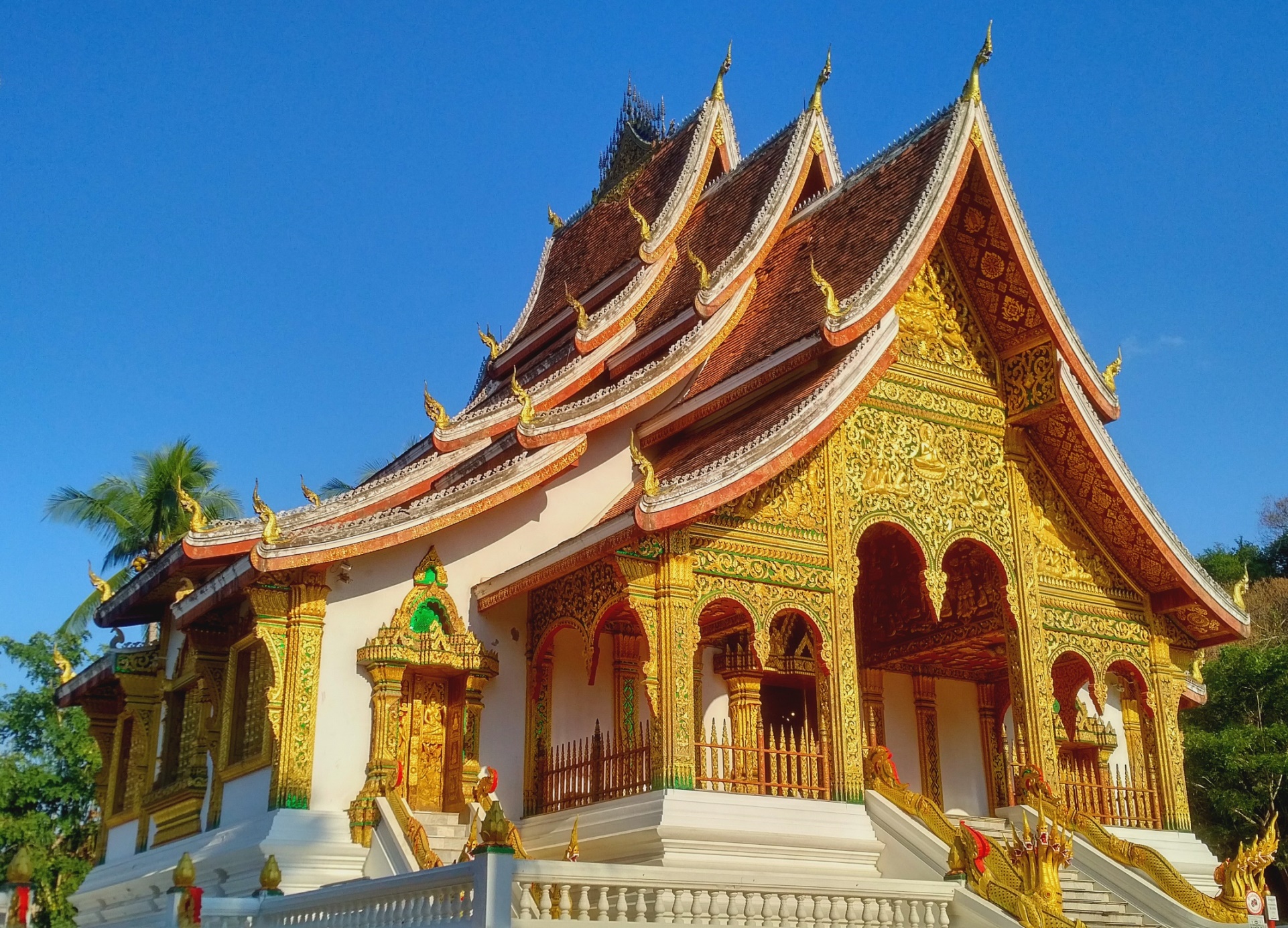
Haw Pha Bang temple, Luang Prabang, northern Laos.
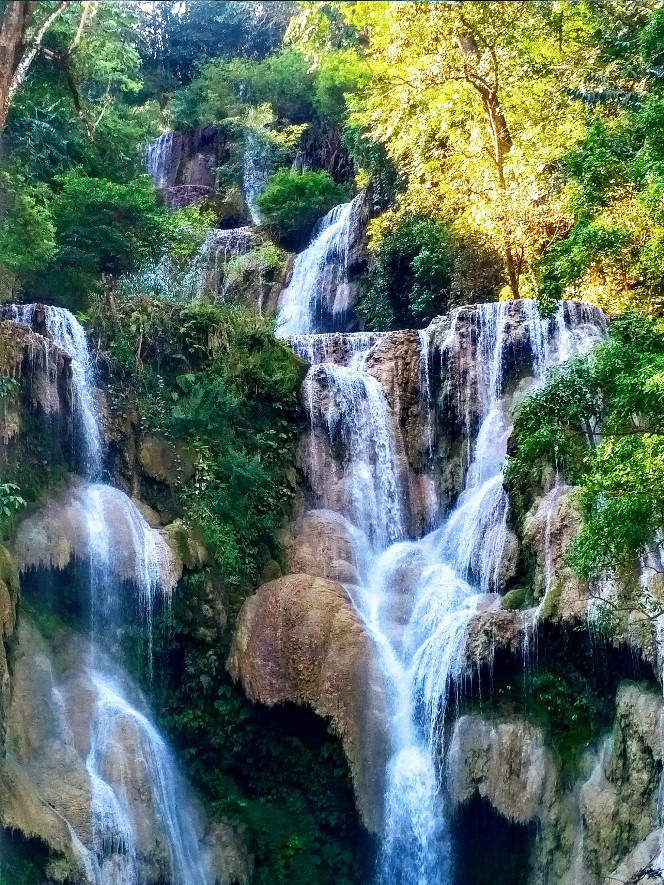
The magical Kuang Si Falls.
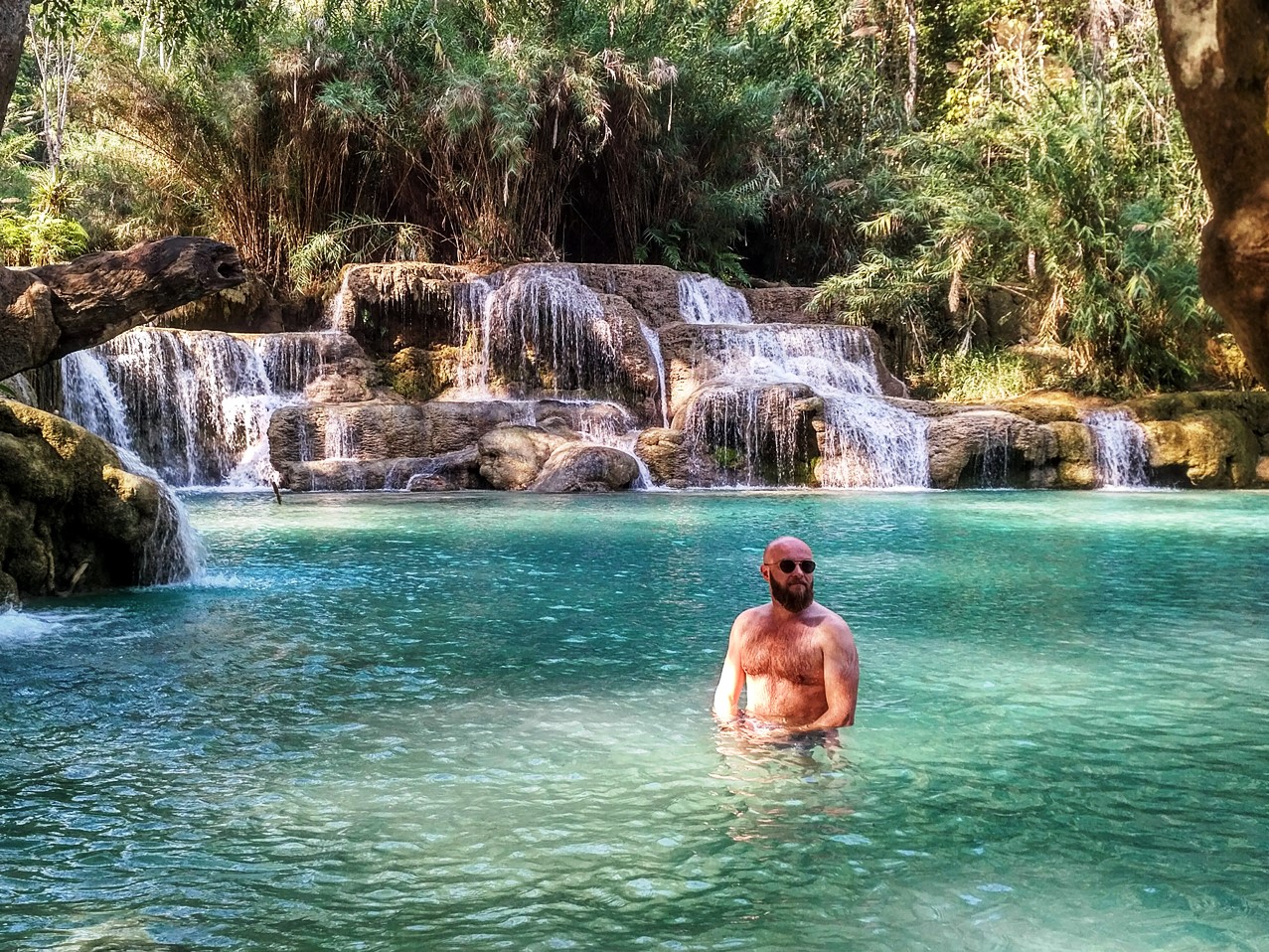
It wasn't long before I was swimming with the fish, which kept nipping at my legs and feet.
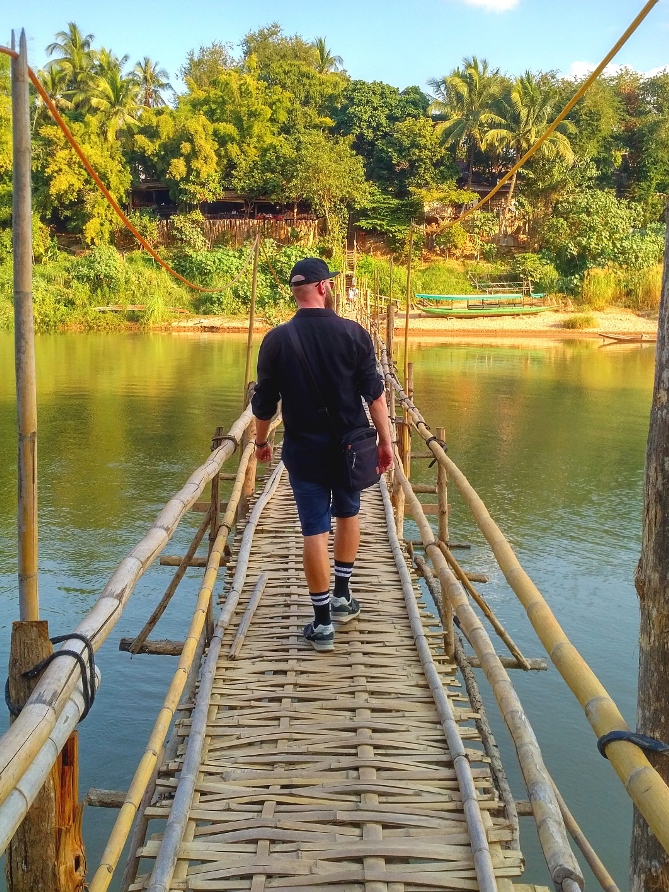
Taking my chances on the bamboo bridge crossing Nam Khan River.
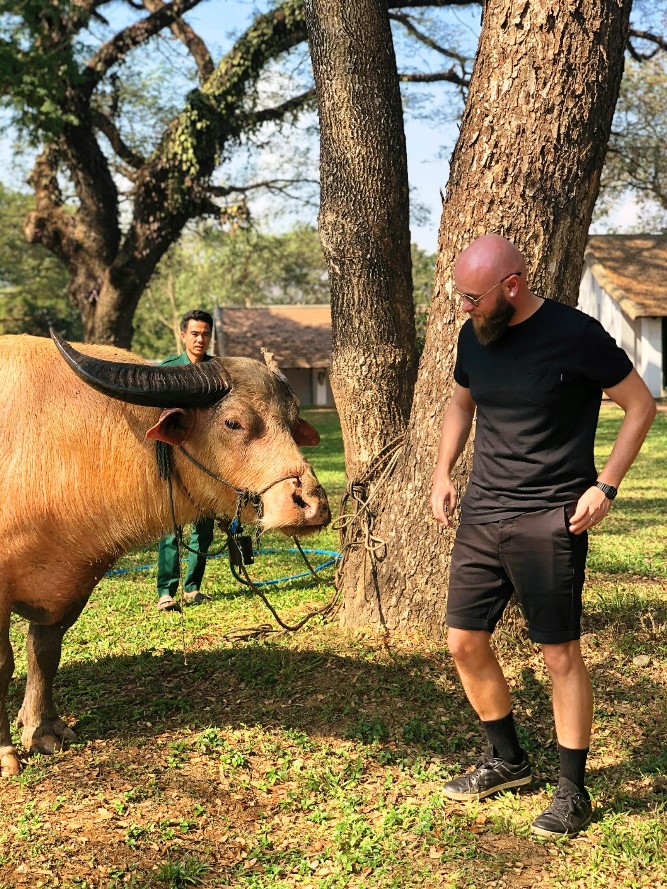
Making friends with Buk Fluke the Water Buffalo.
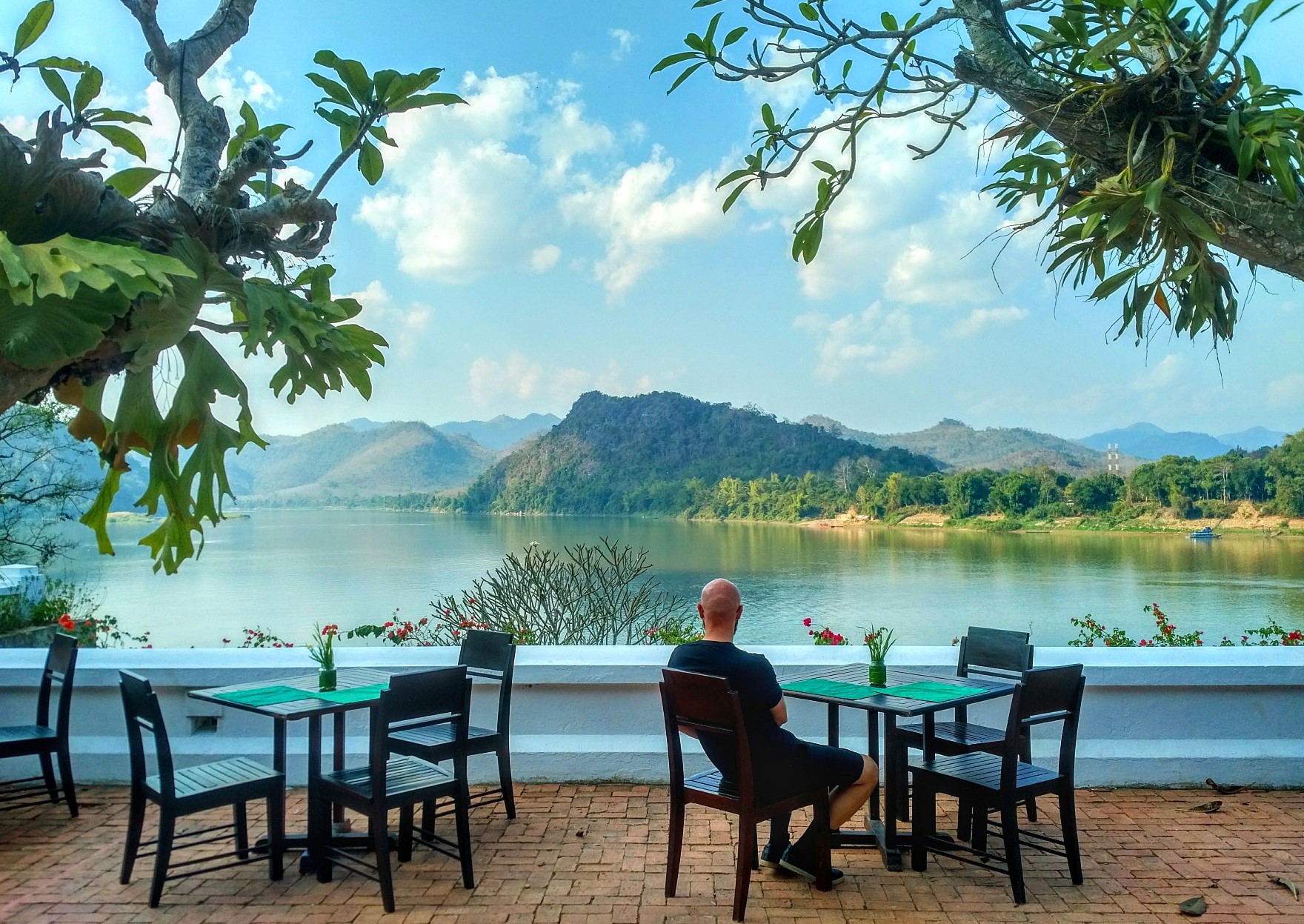
Our hotel overlooked the mighty Mekong River. This was my lunch with a view. The hotel was near-empty so we pretty much had this incredible place to ourselves. After travelling through Southeast Asia and having had a nightmare at nearly every hotel we'd stayed, we had finally found a little peace and quiet...

The sun sets as we cruise down the Mekong River.
travel tips, links & resources
- Southeast Asia is well connected when it comes to airlines. This reality offers valuable opportunities to save travel time avoiding, as it does, the need to go in and out of a hub airport to get to your destination.
- It is good advice to check the safety rating of the airlines before booking. I use the Australian-created Airlineratings.com which awards each airline a star safety rating out of seven using internationally accepted safety parameters. Some airlines in the Southeast Asia region achieve just two stars while others get seven. It is well worth checking out which airline you fly with.
- Getting a taxi anywhere in Bangkok is frustrating. You'll spend precious time stuck in traffic jams inching ahead at a glacial speed. In most cases its better to get a tuk tuk, the underground train (the MRT) or even walk.
- A word of caution about ATMs in Thailand: contrary to how machines work in other countries, in Thailand the cash is released first, followed by your card. This leads to countless travellers - us included I'm afraid - walking away without their card. Laos and Cambodia ATMs worked the other way round.
- In all three countries withdrawing cash from ATMs was expensive: most machines charged me a minimum of AU$6 or as high as AU$11 to get money out. Plan ahead by withdrawing more less frequently or by obtaining a bank card in your home country which refunds such charges. I saved over AU$200 thanks to my ING Direct (Australia) card.
- This is obvious but purchase a pair of light cotton trousers to take with you in your day bag on trips to palaces, temples and even museums in the region: the hot weather dictates shorts and skirts, but cultural sensitivities insist on covering up. It's that or be forced to head back outside of the temple or palace to purchase one-size-fits-all cheap and nasty things. Get a decent pair ahead of time to avoid the hassle and avoid walking around in silly trousers like, seemingly, two thirds of tourists on any given day.
- Cambodia has the Riel as its official currency but for tourists it is unofficially the US Dollar. A word of caution: people are very picky about the condition of the Dollar bills - get passed one with a tear in it and you will struggle to spend it. The Dollar is accepted in Laos but far less commonly so than Cambodia where possessing them is pretty much a necessity.
- Mosquitoes are a concern in this region, even in the dry season. In my experience you are more likely to be bitten waiting for your flight in the airport or on the plane itself, than when you're out and about. Pack some DEET into your carry-on luggage. It's also worthwhile taking anti-Malarial tablets. As far as I could tell, I finished the three weeks without getting a single mosquito bite but better safe than sorry.
- Southeast Asia is a building site. I have never had to switch hotels so often on a trip because of building noise at all hours of the day and night. I found that booking 3* hotels was highly problematic. Do yourself a favour and pay that little bit more to upgrade to something better, quieter and, likely, a little further out of town.
you may also like
